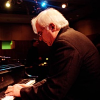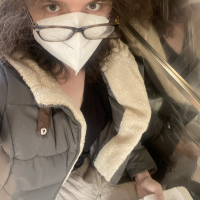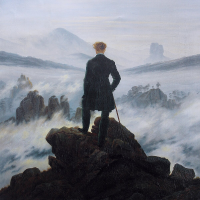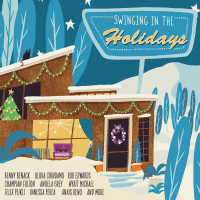Home » Jazz Musicians » George Russell
George Russell
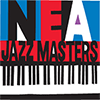
George Russell is a hugely influential, innovative figure in the evolution of modern jazz, the music's only major theorist, one of its most profound composers, and a trail blazer whose ideas have transformed and inspired some of the greatest musicians of our time.
Russell was born in Cincinnati in 1923, the adopted son of a registered nurse and a chef on the B&O Railroad. He began playing drums with the Boy Scout Drum and Bugle Corps and eventually received a scholarship to Wilberforce University where he joined the Collegians, whose list of alumni include Coleman Hawkins, Benny Carter, Fletcher Henderson, Ben Webster, Cootie Williams, Ernie Wilkins and Frank Foster. But his most valuable musical education came in 1941, when, in attempting to enlist in the Marines, he was diagnosed with tuberculosis, spending 6 months in the hospital where he was taught the fundamentals of harmony from a fellow patient. From the hospital he sold his first work, "New World," to Benny Carter. He joined Benny Carter's Band, but was replaced by Max Roach; after Russell heard Roach, he decided to give up drumming. He moved to New York where he was part of a group of musicians who gathered in the basement apartment of Gil Evans. The circle included Miles Davis, Gerry Mulligan, Max Roach, Johnny Carisi and on occasion, Charlie Parker. He was commissioned to write a piece for Dizzy Gillespie's orchestra; the result was the seminal "Cubano Be/Cubano Bop" the first fusion of Afro-Cuban rhythms with jazz, premiered at Carnegie Hall in 1947 and featuring Chano Pozo. Two years later his "Bird in Igor's Yard" was recorded by Buddy DeFranco, a piece notable for its fusion of elements from Charlie Parker and Stravinsky.
It was a remark made by Miles Davis when George asked him his musical aim which set Russell on the course which has been his life. Miles said he "wanted to learn all the changes." Since Miles obviously knew all the changes, Russell surmised that what he meant was he wanted to learn a new way to relate to chords. This began a quest for Russell, and again hospitalized for 16 months, he began to develop his "Lydian Chromatic Concept of Tonal Organization." First published in 1953, the Lydian Concept is credited with opening the way into modal music, as demonstrated by Miles in his seminal "Kind of Blue" recording. Using the Lydian Scale as the PRIMARY SCALE of Western music, the Lydian Chromatic Concept introduced the idea of chord/scale unity. It was the first theory to explore the vertical relationship between chords and scales, and was the only original theory to come from jazz. Throughout the 1950's and 60's, Russell continued to work on developing the Concept and leading bands under his direction.
Read moreTags
George Russell: Concerto For Billy The Kid

by Chris May
Bill Evans' solo (2:29-4:03) on “Concerto For Billy Kid," from George Russell's The Jazz Workshop (RCA,1957), must surely be a contender for the Ultimate Blindfold Test. ...
Continue ReadingGeorge Russell’s New York N.Y. Receives World Premiere At Milton Court

by Chris May
Guildhall Induction Jazz Orchestra & Choir Milton Court Concert Hall Guildhall School of Music & Drama London September 27, 2023 Addressing the audience before the Guildhall Induction Jazz Orchestra's recreation of George Russell's first large-ensemble masterpiece, New York N.Y. (Decca, 1959), director and conductor Scott Stroman explained the choice of repertoire. This is the induction edition of GJO, he said, representing the 2023 cohort of new Guildhall students, who had only been at ...
Continue ReadingGeorge Russell Remembered

by Duncan Heining
How is it that one of the most significant figures in modern jazz is so often overlooked when histories of the music are written? And how come one of its most important composers is not immediately acknowledged when jazz is discussed? Therein hang a number of tangled tales. The centenary of composer, musician, bandleader, educator and musical theorist George Russell arrived in June, 2023. As a theorist his ideas shaped the ways in which modern jazz developed from ...
Continue ReadingTime Spiral: George Russell, Tyshawn Sorey, Yu Nishiyama, Daniel Carter

by David Brown
This week, extended works featuring George Russell's “Time Spiral," Anthony Davis “A Suite for Monk," David Murray and Randy Weston perform “Blue Moses." New releases from Tyshawn Sorey Trio, Yu Nishiyma, Tim Berne's Bloodcount, Daniel Carter, and much more. Playlist Thelonious Monk “Esistrophy (Theme)" from Live at the It Club-Complete (Columbia) 00:30 Keefe Jackson, Oscar Jan Hoogland, Joshua Abrams, Mikel Patrick Avery “Gotta Get Some Sleep" from These Things Happen (Astral Spirits) 01:30 Daniel Carter, Matthew Shipp, William ...
Continue ReadingGeorge Russell: Ezz-thetics & The Stratus Seekers revisited

by Maurizio Comandini
George Russell è uno dei pilastri sui quali si è costruito il jazz moderno degli ultimi 70 anni. Forse non è uno dei primi nomi che ci vengono in mente, ma di sicuro il suo contributo come compositore, come band leader, come musicologo, è fondamentale. Nei primi anni sessanta i suoi album fornirono una interessante variante al free jazz 'classico' che abitualmente associamo ad Ornette Coleman, ad Albert Ayler, a Cecil Taylor e a tanti altri. Russell preferiva ...
Continue ReadingDuncan Heining: George Russell - The Story of an American Composer

by John Kelman
George Russell: The Story of an American Composer Duncan Heining 376 pages, hardback ISBN: 978-0-8108-6997-4 Scarecrow Press 2010 It's been out for a couple years now, but any book about American composer and founder of the Lydian Chromatic Concept of Tonal Organization—if not the most influential musical concepts ever written and applied to jazz, then certainly one of them—warrants attention. That it is as painstakingly researched and compiled by author (and occasional AAJ ...
Continue ReadingIn Memoriam: George Russell 1923-2009

by AAJ Staff
George was such an inspiration to all of us in his sextet. He encouraged us to go beyond our limitations by introducing and suggesting fresh new concepts. As band members (students) he gave us the encouragement we needed to go further and deeper into our musical improvisations.Playing in his band was a turning point in my drumming because of his encouragement and trust in my ability. George was a good drummer himself so he knew what he wanted, ...
Continue ReadingNew England Conservatory Jazz Orchestra Celebrates Music Of George Russell On Thursday, October 19

Source:
Braithwaite & Katz Communications
Ken Schaphorst leads the NEC Jazz Orchestra in its first concert of the year, a celebration of the centennial of George Russell, cherished NEC faculty member, innovative figure in the evolution of modern jazz, the music’s only major theorist, one of its most profound composers, and a trailblazer whose ideas transformed and inspired some of the greatest musicians of our time. The Music of George Russell takes place on Thursday, October 19 at 7:30 p.m. in NEC’s historic Jordan Hall, ...
read more
George Russell at 100

Source:
JazzWax by Marc Myers
June 23rd was George Russell's centenary. He was a composer and arranger and one of jazz's most important figures of the post-war years of the 20th century. He is credited as being the first jazz musician to create a theory of harmony based on jazz rather than European music, which became the key to modal jazz's ignition. All of this was published in his book Lydian Chromatic Concept of Tonal Organization (1953). He's also one of the most overlooked and ...
read more
Stratusphunk: The Life and Works of George Russell By Dr. Duncan Heining Available through Amazon Worldwide

Source:
All About Jazz
Stratusphunk is the story of remarkable musician and a remarkable man. Through his ideas and music, composer, theorist and musician George Russell joins the dots in modern jazz from bebop, though modal and free jazz and into jazz rock. It is hard to imagine another artist, who was both so influential but also so misunderstood. For the first time in paperback and in a newly revised edition, Stratusphunk makes Russell’s story, music and theories available to scholars, students and fans. ...
read more
Weekend Extra: George Russell’s “Honesty”

Source:
Rifftides by Doug Ramsey
When the 1960s jazz avant-garde was cranking up, George Russell (1923-2009) set an example, as was his way. It had been more than two decades since the intrepid composer captured the attention of the jazz world with his 1947 “Cubano Be-Cubano Bop” for the Dizzy Gillespie big band. He had gone on to compose and arrange for leaders as varied and influential as Artie Shaw, Buddy DeFranco and Lee Konitz. Russell’s Lydian Chromatic Concept of Tonal Organization became an influence ...
read more
NEC’s Jazz Studies Department Presents The Music of George Russell with the NEC Jazz Orchestra on October 16

Source:
Ann Braithwaite
Conducted by Ben Schwendener and Featuring Saxophonist George Garzone Thursday, October 16 at Brown Hall NEC faculty member Ben Schwendener will lead the NEC Jazz Orchestra in The Music of George Russell, a program featuring excerpts from several of Russell’s most ambitious works, as well as “All About Rosie,” traditionally included in all Russell programs. The concert takes place at 8 p.m. on Thursday, October 16 at NEC’s Jordan Hall, 30 Gainsborough Street, Boston, MA. The concert is free and ...
read more
George Russell, Composer Whose Theories Sent Jazz in a New Direction, Dies at 86

Source:
Michael Ricci
George Russell, a jazz composer, educator and musician whose theories led the way to radical changes in jazz in the 1950s and ’60s, died on Monday in the Jamaica Plain neighborhood of Boston. He was 86 and lived in Boston. The cause was complications of Alzheimer’s disease, said his wife, Alice. Though he largely operated behind the scenes and was never well known to the general public, Mr. Russell was a major figure in one of the most important developments ...
read more
George Russell, 1923-2009

Source:
Rifftides by Doug Ramsey
George Russell died Monday night. Here are some of the facts of his life, outlined by the Associated Press.
BOSTON (AP) -- Jazz composer George Russell, a MacArthur fellow whose theories influenced the modal music of Miles Davis and John Coltrane, has died. His publicist says Russell, who taught at the New England Conservatory, died Monday in Boston at age 86 of complications from Alzheimer's. Russell was born in Cincinnati in 1923 and attended Wilberforce University. He played ...
read more
NEC Mourns the Death of Jazz Giant George Russell, Faculty Member from 1969

Source:
Michael Ricci
NEC Mourns Death of Jazz Giant George Russell 05 Hon. D.M.
Composer, Theorist, Author of Lydian Chromatic Concept, was Distinguished Artist-in-Residence Emeritus
MacArthur Fellow, NEA Jazz Master, Living Jazz Legend Taught at NEC from 1969
George Russell, author of the Lydian Chromatic Concept of Tonal Organization that under-girded the pioneering modal experiments of John Coltrane and Miles Davis, has died in Boston at age 86. He had been affiliated with New England Conservatory from 1969 when then President Gunther Schuller ...
read more
Jazz Composer George Russell Dies at 86

Source:
Michael Ricci
BOSTON--Jazz composer George Russell, a MacArthur fellow whose theories influenced the modal music of Miles Davis and John Coltrane, has died. His publicist says Russell, who taught at the New England Conservatory, died Monday in Boston at age 86 of complications from Alzheimer's. Russell was born in Cincinnati in 1923 and attended Wilberforce University. He played drums in Benny Carter's band and later wrote “Cubano Be/Cubano Bop" for Dizzy Gillespie's orchestra. It premiered at Carnegie Hall in 1947 and was ...
read more
Ditson Festival of Contemporary Music at Boston's Institute of Contemporary Art

Source:
AMT Public Relations
Inaugural Ditson Festival of Contemporary Music Features Boston's Leading Musicians, Composers, and Ensembles 2008 Ditson Festival is Co-Produced by the Boston Modern Orchestra Project (BMOP) and The Institute of Contemporary Art/Boston Boston, MA--Gil Rose, Artistic Director of the 2008 Ditson Festival of Contemporary Music, today announced the Festival's programming which runs for four days from Sept. 18-Sept. 21, 2008, at the Institute of Contemporary Art, 100 Northern Avenue, Boston. The Festival comprises eight cutting-edge concerts featuring seven world premieres, supplemented ...
read more
"A brain blasting, soul-cleansing expression of absolutely immediate and endlessly creative originality." - Marty Khan






















